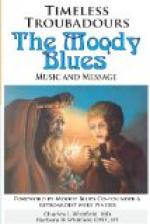En lo sesoun qe l’erbe poynt
E reverdist la matinee
E sil oysel chauntent a poynt
En temps d’avril en la ramee,
Lores est ma dolur dublee
Que jeo sui en si dure poynt
Que jeo n’en ai de joie poynt,
Tant me greve la destinee.
Murnes et pensif m’en depart,
Que trop me greve la partie;
Si n’en puis aler cele part,
Que ele n’eyt a sa partie
Mon quor tot enter saunz partie.
E puis qu’el ad le men saunz part,
E jeo n’oy unkes del soen part
A moi est dure la partie.
“In the season when the grass springs and the morn is green and the birds sing exultantly in April time in the branches, then is my grief doubled, for I am in so hard a case that I have no joy at all, so heavy is my fate upon me.
“Sad and thoughtful I depart, for the case is too grievous for me: yet [137] I cannot go thither, for she has in her power my heart whole and undivided. And since she has mine undivided and I never have any part of hers, the division is a hard one to me.”
This influence was continued in Middle English lyric poetry. These lyrics are often lacking in polish; the tendency to use alliteration as an ornament has nothing to do with such occasional troubadour examples of the trick as may be found in Peire d’Auvergne. Sometimes a refrain of distinctly popular origin is added to a stanza of courtly and artificial character. Generally, however, there is a freshness and vigour in these poems which may be vainly sought in the products of continental decadence. But Provencal influence, whether exerted directly or indirectly through the Northern French lyric school, is plainly visible in many cases. Of the lyrics found in the important MS. Harleian 2253,[37] “Alysoun” has the same rime scheme as a poem by Gaucelm Faidit: it opens with the conventional appeal to spring; the poet’s feelings deprive him of sleep. The Fair Maid of Ribbesdale has a rime-scheme almost identical with that shown by one of Raimbaut d’Aurenga’s poems; the description of the lady’s beauty recalls many troubadour formulae: the concluding lines—
He myhte sayen pat crist hym seze,
[138]
pat myhte nyhtes neh hyre leze,
heuene he hevede here.




